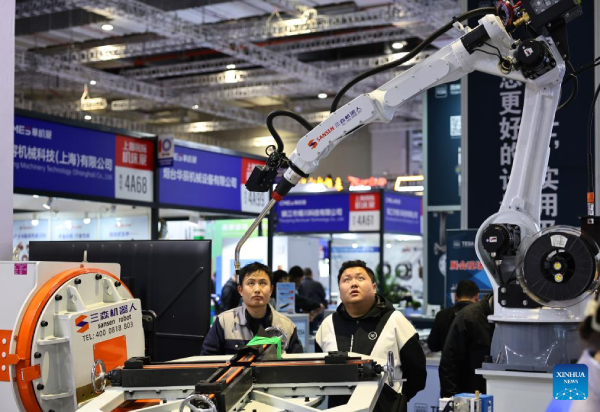Introduction: Chinese: A Language of Global Influence
With its many dialects, Chinese is the most widely spoken language in the world, spoken by more than 1.4 billion people. With China’s rise as a global economic power and its growing influence in trade, technology, and international politics, Chinese is no longer just a national language, but one of increasing global importance, and learning it has become indispensable in the modern era. This article will discuss the contemporary global importance of Chinese in the fields of business and diplomacy, the challenges faced by its learners and the solutions available, as well as the promising professional and educational opportunities that this language opens up in the 21st century.
Chapter 1: Global Power: Economic and Diplomatic Importance
Economic Engine: Language in Business and International Trade
China is now the world’s largest trading power and the second largest importer of goods. This economic reality makes speaking and understanding Chinese essential and crucial for companies and individuals seeking to do business with Chinese partners and customers. The ability to communicate directly in Chinese gives companies a significant competitive advantage and greatly increases their chances of success in international trade.
Recent surveys have shown that Chinese has become the world’s second most important business language after English. This ranking is not based solely on the number of speakers, but includes multiple criteria such as the number of countries that adopt it as an official language, its overall economic impact, and the percentage of people learning the language worldwide. This confirms that the importance of Chinese goes beyond being merely a national language, becoming a pivotal strategic tool in the global economy.
The ability to master Chinese, especially business Mandarin, opens up vast opportunities for professionals. Studies show that professionals who are proficient in business Mandarin see a 15-25% increase in compensation, 74% faster promotion rates, and a doubling of international opportunities available to them. This tangible financial return makes learning Chinese a highly valuable practical investment, especially in vital sectors such as e-commerce, where China is the world’s largest market, and technology and artificial intelligence, where China is leading innovation.
To understand the practical importance of Chinese in a business context, here are some basic words and phrases used in trade and negotiation:
Chinese term Pinyin English meaning
交易 Jiāoyì deal
合同 Hétóng contract
价格 Jiàgé price
折扣 Zhékòu خصم
دفع Fùkuǎn Payment
Cooperation Hézuò Cooperation
Quality Zhìliàng Quality
Quantity Shùliàng Quantity
Market Shìchǎng Market
Supplier Gōngyìngshāng Supplier
Customer Kèhù Customer
Invoice Fāpiào Invoice
Shipping Yùnshū Shipping
Import and export Jìnchūkǒu Import and export
Customs clearance Qīngguān Customs clearance
This table provides immediate practical value to readers interested in doing business with China, as it provides them with basic vocabulary that enables them to begin commercial communication, thereby enhancing the practical usefulness of the article.
Diplomacy and international relations: A voice on the world stage
Chinese is one of the six official languages of the United Nations, and the General Assembly adopted Chinese as an official working language in 1973. This inclusion is not merely a linguistic recognition, but a recognition of China’s growing influence on the international stage and its pivotal role in world affairs.
Speaking and understanding Chinese greatly contributes to enhancing communication and understanding in cross-cultural relations and helps open up new horizons in business, education, and travel. In the context of diplomacy, Chinese Ambassador to the United States Chen Gang pointed out that Sino-US relations suffer from significant misunderstandings as a result of a lack of communication and misinformation, highlighting the utmost importance of language as a bridge for understanding between countries.
China is also working to strengthen its diplomacy to support Chinese-style modernization, reflecting the aspirations of the world’s peoples for peaceful development. This reflects China’s “soft power” strategy, which uses language and culture as tools to strengthen diplomatic relations and build global understanding, thereby influencing the formation of international discourse. Learning Chinese promotes cultural exchange, mutual understanding, and cultural cooperation, which is what modern diplomacy strives for.
Chapter 2: Overcoming the Learning Curve: Challenges and Solutions
Common Obstacles: Tones, Characters, and Listening Skills
Learners of Chinese face many unique challenges that require special effort and adaptation. Pronunciation and tones are by far the biggest challenge, as a single word can have completely different meanings depending on its tone. This requires learners to adapt to subtle changes in tone within a single syllable, which is unfamiliar to speakers of non-tonal languages.
Another major challenge lies in the character-based writing system (Hanzi). Chinese does not rely on an alphabet, but rather on complex symbols or drawings, which makes reading and writing extremely difficult at first. There are approximately 56,000 Chinese characters, although only about 3,000 are used daily in everyday life. This enormous number of symbols requires a strong visual memory and constant practice.
Although Chinese grammar may seem simple in some respects, it follows patterns and rules that may seem strange or counterintuitive to learners from other linguistic backgrounds. For example, word order differs in some cases, and the use of particles to determine meaning requires a precise understanding of context. In addition, listening skills are a major challenge, as they require immediate comprehension of speech, which is difficult in Chinese due to its tonal nature, rapid speech patterns, and diversity of regional dialects. These significant challenges in learning Chinese are not merely technical difficulties, but require a “mindset shift” on the part of the learner, moving away from attempting literal translations or applying the rules of their native language, making it a transformative learning experience that goes beyond simply acquiring vocabulary and grammar.
Effective learning strategies: immersion, practice, and mindset shift
To overcome these obstacles, learners can adopt a set of effective strategies. It is advisable to focus on listening in the early stages to get used to the sounds and natural rhythm of the language, and to imitate native speakers as much as possible. To practice tones, one can use dedicated tone exercises, visual aids that illustrate the tone path, and focus on tongue placement and mouth shape to produce the correct sounds.
As for memorizing characters, you should set aside regular time each day for this task and focus on recognizing patterns and recurring roots within the characters. You can take advantage of modern educational apps such as HelloChinese and ChineseSkill, which offer interactive lessons and voice recognition technology to correct and improve pronunciation. To understand grammar, it is better to focus on understanding basic sentence patterns rather than trying to memorize complex rules, as Chinese relies heavily on fixed patterns.
Immersion in the language and constant communication are among the most important strategies. This can be achieved by joining online chat groups, working with a private tutor, or even traveling to China to interact directly with native speakers. It is also recommended to watch Chinese movies and TV series, listen to music and podcasts, and eat Chinese food, which enhances learning in a rich cultural context. The ability to adapt cognitively to a radically different linguistic system, or “mindset shift,” is key to success in learning Chinese, underscoring the importance of mental flexibility for learners.
The Digital Revolution: Artificial Intelligence and Technology in Language Acquisition
The digital revolution, particularly the development of artificial intelligence, has brought about a major transformation in the ways Chinese is learned. Artificial intelligence offers innovative solutions, such as adaptive systems that provide immediate and personalized feedback on pronunciation, grammar, and vocabulary, helping learners correct their mistakes in real time. It also helps reduce foreign accents by identifying deviations from standard pronunciation and assists in recognizing and correcting handwritten Chinese characters. AI-powered interactive learning platforms, such as SpeakPal AI, provide virtual teachers that allow learners to immerse themselves in real conversation scenarios, intensive tone training, and listening skill improvement.
However, the impact of digital input methods on Chinese language learning is twofold. While input methods such as Pinyin have made it easier to write Chinese characters on digital devices, early and frequent use of Pinyin may slow down the development of character reading skills. This occurs because it interferes with learning the visual-spatial characteristics of characters, as the user relies on selecting the character from a list rather than memorizing and writing it by hand. In contrast, research shows that handwriting greatly enhances this skill, pointing to the need for a balanced approach that combines technology and traditional practices.
The rapid development of the internet and social media has led to the emergence of a contemporary linguistic phenomenon known as “cyber-language.” This language includes new words and terms, slang expressions, and digital abbreviations that reflect ongoing social changes and are influenced by natural phenomena and the personal creativity of users. For example, numbers are used to represent words or phrases phonetically (such as 88 for “bye bye” and 520 for “I love you”), and abbreviations such as XSWL (笑死我了) are used to mean “I laughed myself to death.”
The emergence of “Chinese Internet language” represents a contemporary sociolinguistic phenomenon, where language interacts with technology and popular culture to generate new forms of expression. This illustrates that language is not static, but dynamic and influenced by new environments, raising questions about language standards and the challenges of preserving linguistic heritage in the digital age. While this language promotes linguistic development and diversity, it may hinder language standardization and dissemination, creating difficulties in understanding and standard use of traditional Chinese characters.
To understand this evolving aspect of the Chinese language, let’s look at some common Internet terms:
Chinese term (characters/numbers) Pinyin Meaning in English/Arabic
88 bā bā Bye bye
520 wǔ èr líng I love you
666 liù liù liù Excellent, great
XSWL (笑死我了) xiào sǐ wǒ le Laughing myself to death
牛 (niú) niú Awesome, cool (Awesome, amazing)
Chapter 3: Opening Up Future Horizons: Career and Educational Opportunities
Promising Career Paths
Career opportunities for Chinese speakers are steadily increasing, driven by China’s economic growth and global influence. Translation, both written and simultaneous, is one of the most sought-after professions, especially given the growing relations between China and other countries. This includes translation in the fields of commerce, scientific research, and medicine, where there is an increasing need for qualified translators to facilitate international cooperation.
There are vast opportunities in the business and tourism sectors. Chinese companies operating in Arab countries need employees who are fluent in both Chinese and Arabic to communicate with customers and manage public relations. Knowledge of Chinese also makes traveling to China a smoother experience and allows for greater interaction with the local culture and community.
In the field of education and media, there are opportunities to work in language institutes and international schools, and to offer online Chinese language lessons. The media also offers opportunities for Chinese language graduates to prepare reports, write articles, and create content aimed at Chinese or Arab audiences.
In the technology and engineering sectors, proficiency in Chinese gives students better opportunities to study scientific disciplines in which China excels globally, such as artificial intelligence and engineering. For example, AI developers who are fluent in Chinese earn 23.5% higher salaries, and 83% of technology companies expanding in Asia give priority to Chinese-speaking product managers. This expansion of career opportunities for Chinese speakers goes beyond traditional fields to include vital sectors, reflecting a shift in the global economy where China has become a major player, making Chinese a highly valued skill in the international job market.
To illustrate these opportunities, consider the following table:
Professional field Examples of jobs Added value of Chinese proficiency
Translation Editorial translator, interpreter (business, legal, medical, scientific) Facilitates business, legal, medical, and scientific communication, increasing opportunities for global exposure.
Business and trade Customer relations manager, business consultant, international marketing specialist Improve negotiations, build strong relationships, gain a deeper understanding of the Chinese market, increase salaries and promotions.
Education Chinese language teacher, lecturer at international universities Teach Chinese language and culture, opportunities at international institutes and schools.
Media Reporter, Columnist, Visual Content Creator Prepare content for Chinese or Arabic audiences, understand the media culture of both sides.
Technology and Science Artificial Intelligence Developer, Technology Product Manager, Researcher Higher salaries, priority in hiring, reduce product development cycles for cross-border teams.
Diplomacy and international relations Diplomat, international relations specialist, employee of international organizations Promoting cross-cultural understanding, building bridges of diplomatic communication.
Academic advancement: study and research in China
Learning Chinese is the key to unlocking outstanding academic and research opportunities. Mastering the language gives students opportunities to study and conduct research at prestigious Chinese universities and institutes, especially since China is pursuing a policy of greatly expanding scientific research and higher education. This means that there is significant government investment in educational and research infrastructure, providing a fertile environment for academic growth.
In addition, many universities around the world, including Arab universities, have adopted student exchange programs with their counterparts in China. These programs not only contribute to enhancing students’ language skills, but also provide them with a comprehensive picture of Chinese culture, history, and traditions, reinforcing the importance of language learning in a broader context than mere linguistic communication.
The role of Confucius Institutes: promoting language and culture globally
Confucius Institutes play a pivotal role in spreading Chinese language and culture worldwide. These institutes are public, non-profit organizations that aim to promote the spread of Chinese language and culture in foreign countries. By 2018, there were 525 Confucius Institutes and 1,100 affiliated classrooms in 138 countries and regions around the world.
These institutes are based on the principle of cooperation and partnership with foreign institutes and universities, where classes are organized to teach the language and spread Chinese culture and values. They also support the sending of Chinese teachers to their overseas centers and activate a mechanism for cultural and educational exchange between them and their partners. Confucius Institutes are seen as a key tool in China’s “soft power” strategy, as they are not limited to language teaching but also serve as cultural bridges to promote mutual understanding and deepen relations between China and the rest of the world. Their widespread presence reflects China’s commitment to cultural diplomacy as an integral part of its growing global influence.
Conclusion: Embracing the Future: The Indispensable Role of Chinese in the 21st Century
In conclusion, the Chinese language transcends being merely a tool for linguistic communication to become a vital bridge for cultural understanding, economic cooperation, and diplomatic exchange in an increasingly interconnected world. It is a language that carries a rich cultural heritage and, at the same time, is the language of the future that opens doors to countless opportunities.
As China continues to rise as an influential global power in economics, technology, and politics, mastering its language is no longer an option, but a strategic investment. This investment opens up vast professional and educational opportunities in various fields, from translation and business to advanced technology and international diplomacy. Learning Chinese contributes to building a more connected and understanding world, where individuals, companies, and countries can interact more effectively in the complex global landscape.








